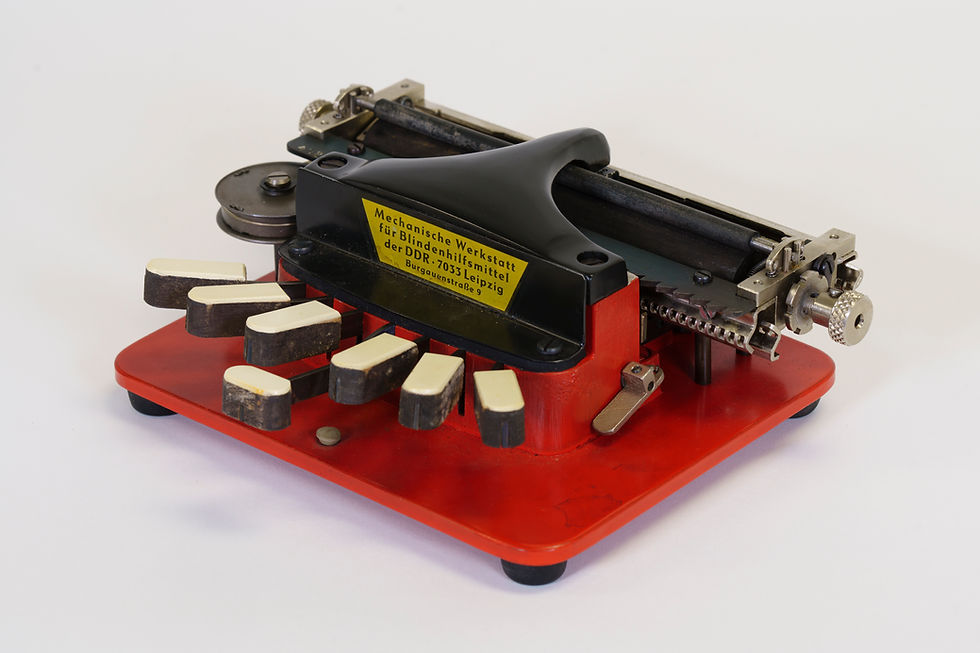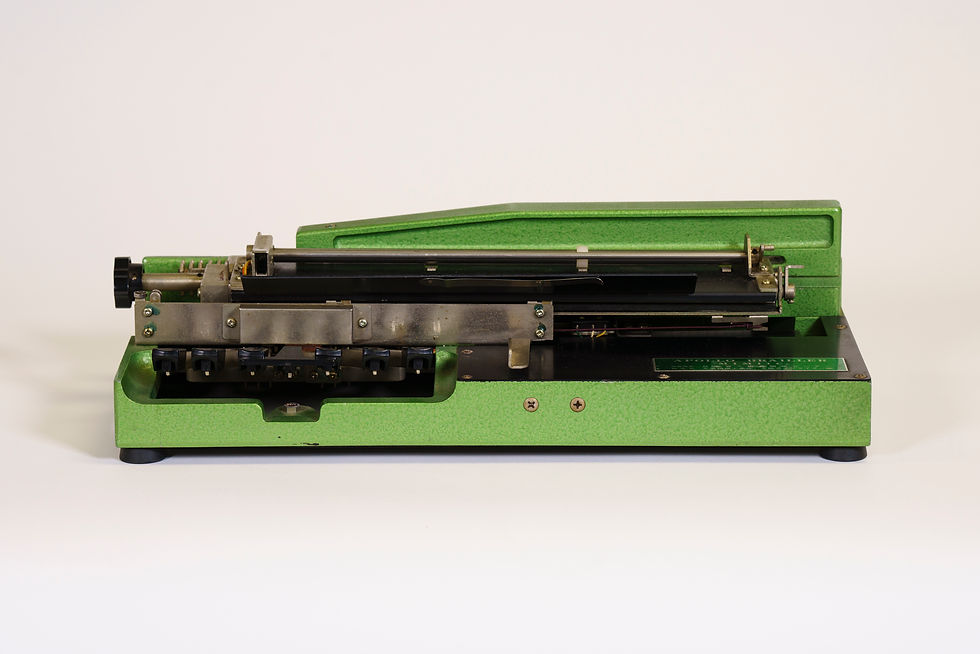Unrestricted Body-minds
盲文打字机
braille typewriter
Blind People's Writing Technology
盲文写字板
braille writing slate
Braille writing slates are rectangular writing tools made of metal or plastic, consisting of two-hinged parts, the upper part called the cover board, and the bottom part called the base board. They come in various specifications depending on their purpose. For example, a 1-line braille writing slate opens and closes vertically and is used specifically for writing braille on labelling tape or at the top of cards. On the other hand, a 27-line braille writing slate can fit an entire A4-sized sheet of paper. The base board has six spherical recesses in each cell. Near the four corners of the slate, there are paper clips and eyelets that secure the braille writing paper sandwiched between the cover board and the base board. Braille writing involves using a braille stylus to emboss recessed dots on braille writing paper, which are then read by touch as raised dots, commonly referred to as "touching forwards and writing backwards."

Upper row from left:
18-line braille slate
Leningrad, Soviet Union
Unknown date
Donated by Huang Jiani (blind)
from China Special Education Museum
27-line braille slate (A4 size)
The Amity Foundation
1980
from China Special Education Museum

Leningrad, Soviet Union Unknown date Donated by Huang Jiani (blind)

The Amity Foundation 1980s

The Amity Foundation 1980s

Leningrad, Soviet Union Unknown date Donated by Huang Jiani (blind)
Middle row:
Braille styluses
France
Unknown date
Donated by Zhou Xilin (blind)
from China Special Education Museum

Bottom row from left:

WINTECH Mfg. Co., Ltd., Thailand Late 20th century to early 21st century Note: There is a label on the back that says “Donation from the Evangelical Center for Visually Impaired ”

WINTECH Mfg. Co., Ltd., Thailand Late 20th century to early 21st century Note: There is a label on the back that says “Donation from the Evangelical Center for Visually Impaired ”

Japan c. 1910 Donated by Shao Suxian (blind),from China Special Education Museum

WINTECH Mfg. Co., Ltd., Thailand Late 20th century to early 21st century Note: There is a label on the back that says “Donation from the Evangelical Center for Visually Impaired ”
9-line braille slate
WINTECH Mfg. Co., Ltd., Thailand
Late 20th century to early 21st century
Note: There is a label on the back that says "Donation from the Evangelical Center for Visually Impaired "
from China Special Education Museum
China Welfare Association of Persons
with Visual Disabilities 4-line braille slate
Shanghai Metalworking Hardware Factory
1950s
from China Special Education Museum
6-line braille slate
Japan Braille Library
1980s
from China Special Education Museum
4-line braille slate
Shenyang Jianxin Factory,
Unknown date
from China Special Education Museum
Perkins Model 13 4-line braille slate
Howe Press, Perkins School for the Blind, Watertown, Massachusetts, USA,
1920s-1930s
from China Special Education Museum
1-line braille slate (cut from 4-line slate)
Shenyang Jianxin Factory
Unknown date
from China Special Education Museum
1-line braille slate
2-line braille slate set
USA
21st century
from China Special Education Museum
Japan
c. 1910
Donated by Shao Suxian (blind),
from China Special Education Museum
The Possibilities of Tactility
Click on the video "button" to play the video:The video introduces the large-format graphical tactile display terminal by the Future Laboratory, Tsinghua University
The Past and Present of Cyborgs
“I asked Minsky about the role of the body in developing emotional systems. Minksy replied, almost in a stern manner, to my question: If the body was paramount, how were disabled people or those with limited control over their bodies able to think? … The analogies between disabled bodies and machine were a recurring theme.”
——Kathleen Richardson: An Anthropology of Robots and AI : Annihilation Anxiety and Machines.
Courtesy MIT Museum
Color photograph of inner mechanisms of prosthetic devices displayed on a rack labelled "Liberty Technology".

MIT Artificial Intelligence Laboratory Robotic Arm (Minsky Arm)
Courtesy MIT Museum



This is the second "arm" developed by Marvin Minsky and Seymour Papert in their multi-year project to develop a computer system that could "see" and "manipulate" objects independent of human control.
Disability is Situational
Stair-Climbing Wheelchair
Courtesy MIT Museum
self-propelled stair-climbing and descending wheelchair - Courtesy MIT Museum

Clear plastic wheelchair frame with rubber-tipped spoked wheels (large in front, small in back); motor in back; white profile siting in chair. On red-painted wooden steps.
Ernesto Blanco has been waiting half a century for someone to build a full-scale working version of his self-propelled stair-climbing and descending wheelchair. In 1959, the National Inventors Council offered a $5,000 prize for the design of a wheelchair that could climb stairs. Blanco submitted his design in 1962. The Council never awarded the prize, but Blanco was so convinced his design would work that he built this one-quarter scale model to prove the concept. How? The secret is the angles and the fact that "static reactions are always vertical and have no tendency to slip," explained Blanco.
Blanco not only brought this "inventional wisdom" to his MIT students, but also conveyed a deeply held belief that solving a problem such as a stair-climbing wheel was a form of social justice and, therefore, progress. In 1999, Dean Kamen introduced the iBot, a fantastic, motorized wheelchair, but production stopped in 2009 because neither insurance nor Medicare would pay for it. Blanco saw that as a challenge and the reason he still wanted someone to build his chair.
Click on the video "button" to play the video:
the video introduces a demo of the electric upstairs and downstairs kit
The Art of Synesthesia
Tangible Ceramic Music Interface
Wang Yun 's research group, The Future Laboratory, Tsinghua University
Presented at the 2022 AsiaHaptics Conference

The ceramic tactile music player is a tangible music playback interface that allows people to experience a 30 second selection of the guzheng song "Spring River Flower Moonlight" through multimodal perception. The device mainly consists of ceramic modules, capacitive touch sensors, main control board, and support structure. After the touch signal is input into the computer, it will be connected to the virtual instrument and output MIDI audio. The circular ceramic module belt is not only a physical music progress bar, but also a carrier of various tactile information. Each ceramic module group maps a note to achieve coupling between tactile signals (size, surface texture, and positional changes) and musical elements (length, fingering, and pitch), providing a tangible experience for the experimenter when experiencing music. When the experimenter touches the device, if their arms and hands move too fast, too slow, or too discontinuous, they will immediately receive audio feedback so that they can choose to fine tune their movements to match the correct music speed.
Music Pool
Accessible Music Installation Design Workshop
The Future Laboratory, Tsinghua University
By using the similarities between sound waves and water waves, the audibility of sound waves is transformed into the visibility of water waves, and then the image of water waves is transformed into the entire three-dimensional space through different colors of light and shadow, forming a complete audio-visual experience.

The initial demo is connected to the MIDI keyboard through a pressure sensor to obtain the scale, intensity, and rhythm played by the user. Then connect to Arduino, which controls seven servo motors (corresponding to seven tones), fans, and motors to gently tap, blow, and hit the water surface, forming different ripple effects. The beauty of the ripple form is used to demonstrate the harmony and dissonance of the music. At the same time, combined with real sampled water droplet sound, it provides a complete auditory experience for the healthy listener.

Click on the video "button" to play the video:
the video introduces the Accessible Music Installation Design Workshop






































